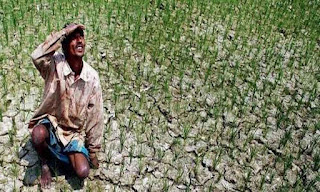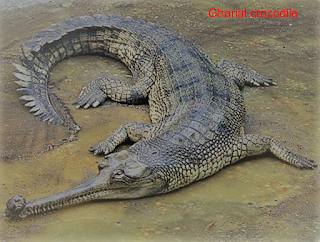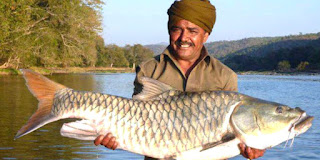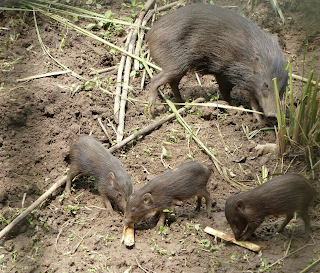Hindu god Varuna, riding Makara, "a mythical being" which was sometimes (like on this 17th century illustration) depicted as a crocodile...
So why would Varuna ride on a crocodile? To answer this question, we first have to look into who Varuna is. Actually who he was, at the time when his mythology and symbolism was developed...
During the Vedic period, Varuna was "The Man", the Sky God who controlled "The Waters": sea, rivers, rain...As one would expect from a Sky god in India, where rivers are filled with the rain that arrives with the monsoon winds from the sea...
In Vedas, Varuna was also twinned with Indra, the Storm god, and together they are referred to as Indra-Varuna. In Rg Veda 4.42, Varuna explicitly states the connection between himself and Indra:
"I, Varuna, am king...I, Varuna, am Indra [too]"
Eventually, through some political machinations, Indra became the overall ruler of the skies and rain...And Varuna was officially relieved of his "water duties"...
But, the Vedic Varuna, is being revered even now as the God of Rain...
When it rains for the first time during the monsoon, tillers of agricultural fields still say, “Varuna-demudu-karunichaadu” (God Varuna has shown empathy)...
But sometimes Varuna gets angry, monsoon rains are late or not as plentiful...
And when there is a low rainfall, because the Rain-God is angry or upset, the Varuna Yajna ritual is performed, during which temple priests immerse themselves in huge barrels of water, chanting Lord Varuna’s name...
So here we have a rain god. And he is riding on a crocodile...Why?
Remember when in my post "Musth" I explained why Indra, Varuna's alter ego, is riding on an elephant?
It is all because Indian elephants mate between Jun and Sep, during the monsoon season...
With the peak of the mating season coinciding with the peak of the rain season, Jul/Aug...
So elephant that Indra rides on is just an animal calendar marker for rain season...So why is Varuna riding on a crocodile? Again, crocodile here is an animal calendar marker for the monsoon, rain season...
Remember my post "Blue boy" about the crocodile related folklore from China? The post about Kiao (Jiaolong)...
While I was researching it, I learned that there are three main crocodile types that live in India: gharials, muggers and salt water crocodiles...
And then I came across this paper "Aquatic Faunal Diversity in Eastern Ghats" which said that in India: "Hatching occurs during June and July in gharials and muggers and July and August in salt water crocodiles."
Considering that the crocodile eggs incubation period is between 55 and 85 days, that means that the eggs are laid from around the beginning of summer, Apr/May...And the beginning of the monsoon season...
And as the crocodile mothers stay around their nests, and guard them ferociously, the sudden appearance of all these irritable crocodile mums on river banks is the sign that "Varuna the Rain God" is on his way...
The crocodiles river bank invasion lasts until the last croc baby is born, around the peak of the monsoon, Jul/Aug...And then they disappear into the churning waters of the overflowing rivers (river water levels peak during the peak monsoon)...
Hence Varuna rides on a crocodile...Except he isn't really riding on a crocodile. He is riding on a Makara, "a mythical being" from Hindu mythology. Which is sometimes depicted as a crocodile...But mostly it is a composite animal, half terrestrial and half aquatic...
But don't be fooled by the priests...What I will to show in this post is that Makara is not "a chimeric mythical being". Instead, it is a complex animal calendar marker for the monsoon season...
In its simplest form, Makara is "Half elephant, half fish"...
Well we have seen that Elephant mating season overlaps with the monsoon season. So that explains the elephant part. But what about the fish part?
Remember this post, "Dragon gate" about fish animal calendar marker from China? Which was based on migratory carp, which starts swimming up the rivers at the beginning of the monsoon season in China...
Wherever we find big migratory fish, we find them also embedded into local mythology as deified calendar markers...
Remember this post, "Fig with bulls" (and fish)?
In it, I talked about Indus river migratory "palla" fish and all the fish depictions on Indus Valley civilisation artefacts...
"Palla" fish migrates into and out of Indus River during the monsoon season which in Indus Valley lasts between Jun and Sep. So is the fish part of Makara animal calendar marker "palla" fish? I originally thought so...
Possibly. But today I discovered another migratory fish that lives in Indian rivers: mahseer. This giant fish migrates upstream at the beginning of the monsoon and spawns during the period between Jul to Sep...Peak monsoon season...
So considering that mahseer is much bigger than palla, and much easier to spot migrating, I think that this is even better candidate for the fish animal calendar marker for monsoon season...And the tail part of Makara...
But there is actually another migratory aquatic animal, that swims up Indian rivers during monsoon season. South Asian river dolphin, also known as Ganges dolphin.
During monsoon season, these dolphins migrate to tributaries of the main river systems, "sometimes swimming along with their beaks emerging from the water, and jumping partly or completely clear of the water"...
Not something you would miss if you lived by the river...
So we have mad rampaging mating elephants and giant fish swimming up rivers, as the rain pour down from the sky...Hence Varuna riding on Makara, a "mythical beast", half elephant, half fish...
But believe or not Makara can get even more elaborate than this. It is "also shown in an abstract, chimeric form with head and jaws of a crocodile, an elephant trunk, lion's feat, fish scales and a peacock tail"...This thing...
Insane, right? If you didn't know about complex animal calendar markers, you would think that these guys must have been smoking some really strong stuff when they invented something like this...🙂
But we know that elephant and crocodile and fish are all animal calendar markers for monsoon season. So what about lion and peacock?
Well, why is Leo marking Jul/Aug? Cause this is when the main mating season of Eurasian lions starts. And has always started...Leo originally had nothing to do with stars...
And guess what happens in Jul/Aug in India? Monsoon peaks...
What about peacocks? Well, the breeding season of the Indian peafowl is closely related to the monsoon. It starts just before the monsoon arrives, in Apr/May in southern India and in Jun in Northern India...
The loud peacock's call, resembles the "miaou" of a gigantic cat. In Northern India it is said to form, the syllable “Menhao” meaning “Come Rain!” for the peacock is especially noisy at the approach of the rainy season...
Sooo...Another two animal calendar markers for the monsoon season...So every one of the animal bits that were used to create magical vehicle of Varuna, the old god of monsoon, is an animal calendar marker for monsoon season...
Oh by the way, Makara is not only the vehicle of Varuna. The personification of the River Ganga also rides on Makara?
Why? Because Ganges river water level peaks during the peak of the monsoon season...I talked about this in my post "Ardhanarishvara"...
And why is goddess Ganga holding a lotus flower while riding on a crocodile? Cause lotus peak flowering season is July-August, the peak monsoon season in the Ganga river catchment area...When crocodiles hatch...
Lakshmi (I talked about here in my post "Modesty"), the goddess of prosperity and wealth, who is associated with elephants and lots, also rides on Makara...
Prosperity in India is directly dependant on agriculture which is dependant on the monsoon...Hence all the plants growing out of Makara's body and pouring out of Makara's mouth...
BTW, goddess Sarasvati ("Monsoon flood") also rides on Makara...I wonder why? 🙂 I talked about Sarasvati and her sisters in my post "Bitch of the gods"...
In even more complex form, Makara is said to have: "the crocodile jaws, elephant trunk, lion's feet, wild boar's tusks and ears, monkey's eyes, fish scales and peacock's tail". 🙂
Ok, here we go again...Monkey...If I was a betting man, I would bet that the monkey here is sacred Hanuman langur...
And this monkey's peak mating season is Jul-Oct, peak monsoon season...
So that fits...
Oh BTW, isn't Hanuman, divine monkey from Vedas, "who was stealing offerings dedicated to Indra, the God of Rain"? The monkey whose father was Vayu, the God of (monsoon) Winds? I mean Hanuman monkeys are all conceived during the time when monsoon wind blows and rain falls...
Finally what about the boar...This was really annoying. The Indian wild boar (seriously cool looking beast) starts mating in Oct/Nov, like all the other wild boar, hence wild boar being pretty universal animal calendar marker for Oct/Nov and winter...

I was about to give up, and admit that I really have no idea why boar was used as part of the Makara complex animal calendar marker for monsoon season...
And then I remembered my post "Lei Kung" about thunder god from Chinese folk religion. Where we discovered that in China it was wild boar birthing, not mating season, that was the important event used to create calendar marker.
Remember, animal calendar markers are created from both mating (Leo, lion mating season) and birthing (Taurus, auroch calving season).
Indian wild boar piglets are born between Mar and May. Just before the beginning of the monsoon season...So is this why wild boar?
And, there is another wild pig species in India, which gives birth to piglets exactly at the beginning of the monsoon, in Apr/May: Pygmy hog...
Soooo....I think this fits too...
That's it...What do you think? Cool?
To read more about ancient animal and plant calendar markers, start here…then check the rest of the blog posts related to animal calendar markers I still didn't add to this page, and finally check my twitter threads I still didn't convert to blog post...I am 9 months behind now...
































I'm interested as to which of the Vedas mention Varuna upon Makara. I do not find "makara" in the Sakala recension (translation) of the Rig Veda.
ReplyDeleteThat Veda has hymns (the Samhita) as considered Sind / upper Punjab / Rajasthan (even Central Asia!). What you have posted implies the Bharat peninsula and the Ganges, where the crocodiles live and the monsoon matters.
George M Williams' Handbook of Hindu mythology (2003) p. 294 tells me that the Purânas (post AD 250, per W Doniger) elaborate most upon Varuna-Makara.
The "Vedic Era" implies the other Vedas, preceding the Purânas; that's where we might find Makara.
Did I say that Vedas mention Varuna on Makara?
DeleteNo, you didn't. I was just trying to clarify this post (or, help you clarify it...).
DeleteWesterners like myself don't know "The Vedas" offhand. For my part I had a vague idea of the Mitanni following some Vedic gods... in northern Iraq; also of the Avesta having some parallels with "The Vedas". Turns out: the Central-Asian themes apply primarily to the Samhita hymns in the Rig Veda.
"The Vedas" are a sprawling collection of Sanskrit not very well edited to this day; most of it Indian as you note, but not all of it, and Westerners are mostly exposed to the oldest and most Central-Asian side of it, which is the shortest side of it.
I spent some hours today finding out that "the Vedic period" refers to the Indian side of it, thus excluding the Samhita hymns in the Rig Veda.
So my question still stands, which is not an accusation against your post here nor against you: which Vedas (there are four; Rig Veda is only the first) start dealing with India, not Central-Asia? And which part of those Vedas (Samhita is the hymn part, we also have Upanishads and other parts)?
Indian mythology is part of the mythological space-time continuum which covers the whole of Eurasia, from Mesolithic to modern times...The important thing here is that regardless who and when for the first time started mapping local animal and plant calendar markers to already existing gods like Indra-Varuna, we can only understand things like "Varuna rides on Makara" through these calendar markers...Just like everywhere else...
DeleteIndra-Varuna
ReplyDeleteUdar-Varnica
Grom div?
I just came upon this post and could not stop reading it. You've really done your research and supported your statements. It's all very fascinating and I will definitely be reading more of your blogs. Thank you for your writing this.
ReplyDelete